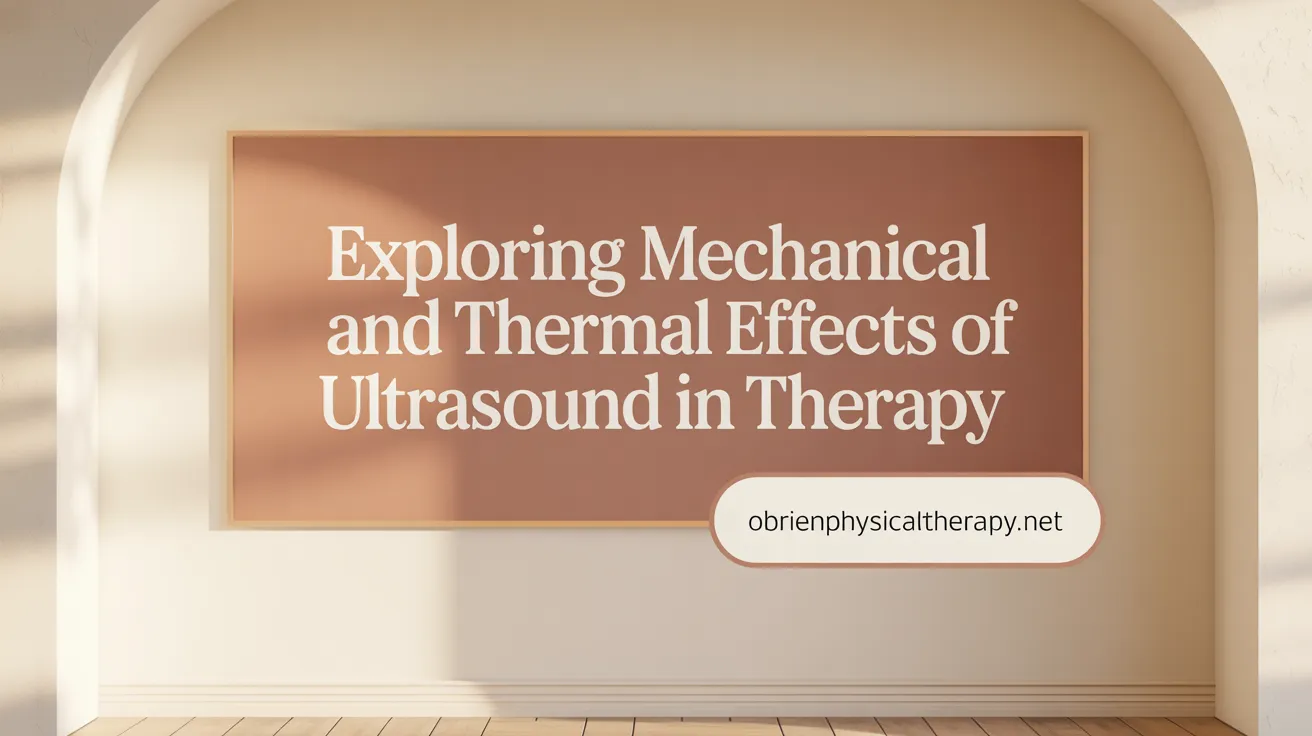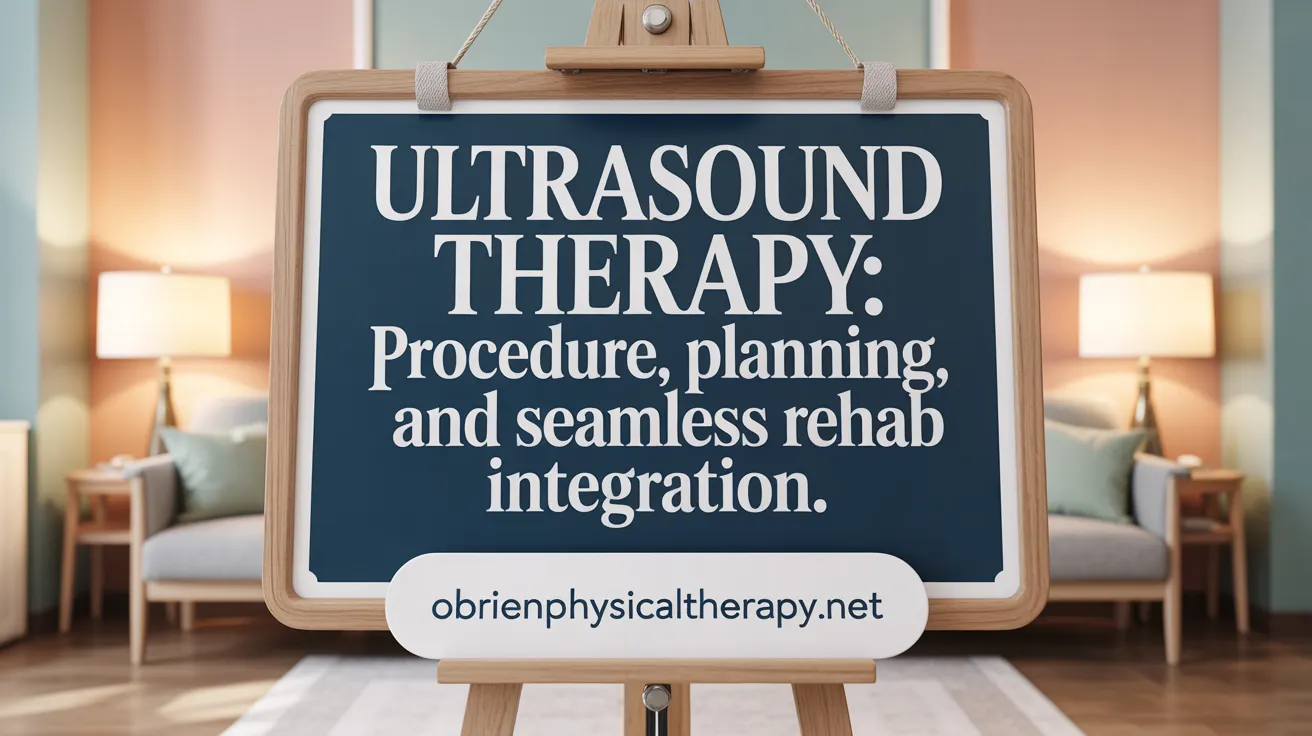Introduction to Ultrasound Therapy in Rehabilitation
Ultrasound therapy has revolutionized rehabilitation by offering a non-invasive, effective method to accelerate healing, reduce pain, and improve function in patients with musculoskeletal and soft tissue disorders. Leveraging mechanical sound waves, this therapy stimulates tissue repair through both thermal and non-thermal mechanisms, making it a versatile tool in physical therapy and pain management. This article delves into the principles, applications, efficacy, and safety of ultrasound therapy in modern rehabilitation practices.
Fundamentals of Ultrasound Therapy: Mechanisms and Biological Effects

How does ultrasound therapy work at the tissue level?
Ultrasound therapy uses the piezoelectric effect, where electrical signals cause crystals inside the ultrasound probe to vibrate and produce mechanical sound waves beyond the human hearing range. These waves travel into the body, inducing oscillation of tissue particles.
Basic principles of ultrasound therapy
The mechanical waves delivered can produce two main effects: thermal and non-thermal. Thermal effects occur as ultrasound energy is absorbed by tissues, especially those rich in collagen such as tendons, ligaments, and fascia, increasing the temperature of these tissues. This heat promotes blood flow, relaxes muscles, and helps reduce pain.
Piezoelectric effect and mechanical waves
The crystals convert electrical energy into mechanical vibrations. These high-frequency waves transfer energy to the tissues, stimulating microscopic vibrations that facilitate biological responses (Piezoelectric crystals in ultrasound).
Thermal and non-thermal effects on tissues
Thermal effects involve deep heating, which enhances blood vessel dilation and accelerates metabolic processes. Non-thermal effects include cavitation—the formation of microscopic gas bubbles—and acoustic streaming, which increase cell membrane permeability and promote cellular activity necessary for healing, such as collagen synthesis and fibroblast proliferation (Thermal effects of ultrasound, Cavitation effects in ultrasound treatment.
Tissue absorption and impedance
Tissues vary in how they absorb ultrasound due to differences in impedance and composition. Protein-rich tissues absorb ultrasound energy more efficiently, making therapy particularly effective in targeting ligaments, tendons, and scar tissue, while tissues like fat and muscle absorb less (Ultrasound absorption and attenuation).
Phases of tissue repair influenced by ultrasound
Ultrasound therapy supports multiple healing stages: during inflammation, it optimizes the immune cell response; in the proliferation phase, it stimulates fibroblast activity and collagen formation; and during tissue remodeling, it assists in proper collagen fiber alignment and the transition of collagen types, improving tissue strength and repair quality (Ultrasound in tissue healing phases.
These mechanisms together help accelerate tissue healing, reduce pain, and improve function in musculoskeletal injuries and other conditions treated with ultrasound therapy.
Clinical Applications of Ultrasound Therapy in Musculoskeletal Rehabilitation

What musculoskeletal conditions can be treated with ultrasound therapy?
Ultrasound therapy is widely used for a variety of musculoskeletal conditions including osteoarthritis, tendonitis, bursitis, ligament sprains, muscle strains, frozen shoulder, carpal tunnel syndrome, myofascial pain syndrome, and scar tissue adhesions. These conditions benefit from the therapy's ability to reduce pain, enhance blood flow, promote tissue healing, relax muscles, and break down scar tissue.
How are thermal and mechanical modalities used in treatment?
Ultrasound therapy employs two main modalities: thermal and mechanical. Thermal ultrasound produces deep heating by causing micro-vibrations that increase tissue temperature, helping relax muscles, ease pain, and improve circulation. Mechanical ultrasound uses cavitation and acoustic streaming to induce vibrations that can break down scar tissue, reduce swelling, and stimulate cellular repair processes.
How does ultrasound therapy assist in soft tissue injuries and chronic pain?
For soft tissue injuries like sprains, strains, and tendinitis, ultrasound accelerates healing by stimulating collagen synthesis and improving blood flow. It also offers pain relief and reduced inflammation in chronic cases such as rheumatoid arthritis and myofascial pain syndrome. These effects aid in restoring function and mobility (source, source).
Is ultrasound therapy used alongside other rehabilitative interventions?
Yes, ultrasound therapy is often combined with exercises, joint mobilization, massage, and other physical therapy modalities. This adjunctive use enhances pain relief, improves range of motion, and supports overall rehabilitation, especially in conditions like frozen shoulder and ligament injuries (source, source).
What types of conditions benefit most from ultrasound therapy?
Conditions involving high-protein soft tissues such as tendons, ligaments, and fascia respond particularly well due to better ultrasound absorption (source. Acute injuries respond to pulsed ultrasound minimizing heat, while chronic conditions often benefit from continuous thermal ultrasound. However, evidence varies across conditions, with stronger support for its use in osteoarthritis and myofascial pain syndrome than in some others like adhesive capsulitis (source, source).
Ultrasound therapy offers a noninvasive, safe, and generally well-tolerated approach for musculoskeletal rehabilitation, making it a valuable tool in physical therapy practice (source).
Efficacy and Evidence: Evaluating Ultrasound Therapy in Rehabilitation
What is the current evidence supporting ultrasound therapy's effectiveness in rehabilitation?
Ultrasound therapy has been widely studied for its role in musculoskeletal rehabilitation with mixed findings. Systematic reviews and meta-analyses have assessed its benefits across various conditions, reporting that ultrasound can significantly reduce pain in some cases but not universally improve function.
Clinical trials show ultrasound therapy to be effective for pain relief in specific disorders such as knee osteoarthritis and myofascial pain syndrome. However, for other common conditions like shoulder pain and chronic low back pain, many high-quality placebo-controlled studies found limited or no clinically meaningful improvement with ultrasound treatment.
One example of mixed results is lateral epicondylitis (tennis elbow), where meta-analyses indicate only modest improvement, but confidence intervals include the possibility of no effect, signaling uncertainty around clinical significance. Regarding adhesive capsulitis, adding ultrasound therapy to exercise and mobilization did not provide additional pain relief or functional gains compared to placebo.
These conflicting outcomes are partly due to variability in ultrasound parameters (such as frequency, intensity, and duration) and methodological differences in trials. This heterogeneity highlights the ongoing need for well-designed research to establish optimized treatment protocols, clarify which patient groups benefit most, and demonstrate clear functional improvements over standard care or placebo.
Overall, while therapeutic ultrasound remains popular in physical therapy, its clinical efficacy varies by condition, and practitioners should consider current evidence and individual patient response when integrating ultrasound therapy into rehabilitation programs.
Safety Profile and Contraindications in Therapeutic Ultrasound Use

What are the safety considerations and risks associated with ultrasound therapy?
Therapeutic ultrasound is generally regarded as a safe treatment when administered by trained professionals following proper protocols. Key safety considerations involve avoiding certain sensitive areas during treatment such as the pregnant uterus, spine, eyes, pacemakers, metallic implants, regions with active infections, or cancerous tissue.
Risks are infrequent but can include superficial skin burns, especially when the ultrasound probe is held stationary for too long or used at excessive intensity. Patients may experience mild discomfort due to shockwaves during some mechanical ultrasound procedures. More serious complications, such as internal hemorrhage or tissue scarring, are rare and usually linked to high-power applications like extracorporeal shockwave lithotripsy.
Contraindications and precautions
Contraindications for ultrasound therapy include:
- Pregnancy (particularly over the abdomen or lower back)
- Over the spinal cord or eyes
- Individuals with pacemakers or implanted electronic devices
- Areas with active infections or open wounds
- Malignant tumors
Proper assessment and adherence to these precautions help minimize risk as outlined in ultrasound therapy safety and cleaning guidelines.
Safe application techniques
Safe and effective use of therapeutic ultrasound requires moving the transducer continuously to prevent hotspots and burns. Use of coupling gels or water-based media ensures good transmission of ultrasound energy to tissues and reduces energy reflection. Treatment parameters such as frequency, intensity, and pulse mode should be tailored to the condition and patient tolerance as described in ultrasound therapy procedure protocols.
Regulatory approval and clinical safety standards
Ultrasound therapies like extracorporeal shockwave lithotripsy, high-intensity focused ultrasound, and ultrasound diathermy have received FDA approval for specific indications. Clinical studies support their safety when used according to approved guidelines. Healthcare providers should follow evidence-based protocols and maintain proper device maintenance and hygiene to prevent complications, as discussed in FDA-approved ultrasound therapies and ultrasound therapy safety.
In summary, therapeutic ultrasound is a low-risk modality with few adverse effects when appropriately applied, making it a valuable tool in rehabilitation and pain management.
Advanced Ultrasound Modalities: Innovations and Specialized Applications
What advanced ultrasound technologies and applications exist in rehabilitation?
Advanced ultrasound technologies have significantly expanded the scope of rehabilitation treatments beyond traditional methods. One prominent innovation is High-Intensity Focused Ultrasound (HIFU), which precisely targets deep tissues to ablate unwanted cells. When combined with MRI-guided HIFU treatment, HIFU offers accurate, noninvasive treatment options for conditions like ultrasound for uterine fibroids, ultrasound treatment for prostate cancer, and some skin abnormalities, improving safety and efficacy.
Low-Intensity Pulsed Ultrasound (LIPUS) is another specialized modality that delivers controlled, low-power pulses to promote bone healing and soft tissue repair. This therapy leverages non-thermal effects to stimulate cellular activity, accelerating recovery from fractures and musculoskeletal injuries.
Extracorporeal Shockwave Lithotripsy (ESWL) uses ultrasound-generated shockwaves to fragment kidney stones without incisions, and also enhances clot dissolution in thrombolytic treatments. This modality represents a critical advancement in noninvasive medical interventions.
Phonophoresis enhances drug delivery by using ultrasound to increase skin permeability, allowing topical medications such as anti-inflammatories to penetrate more deeply into affected tissues, thereby improving therapeutic outcomes.
The successful application of these advanced modalities depends on an interprofessional approach. Collaboration among clinicians, physical therapists, and specialists ensures comprehensive care coordination, optimized treatment protocols, and enhanced patient outcomes in ultrasound-based rehabilitation.
Practical Considerations: Procedure, Treatment Planning, and Integration in Rehabilitation Programs

What does an ultrasound therapy session involve, and how is it integrated into rehabilitation?
An ultrasound therapy session typically begins with the application of a conductive gel on the skin over the targeted area. This gel acts as a coupling medium, minimizing reflection and ensuring efficient transmission of ultrasound waves into the tissues. The therapist then moves the ultrasound transducer in slow circular motions across the skin for about 5 to 10 minutes per session.
Depending on treatment goals, the ultrasound can be delivered continuously to produce thermal effects—such as deep tissue warming for pain relief and muscle relaxation—or pulsed to generate non-thermal effects like cavitation which aid tissue repair. The procedure is painless, non-invasive, and usually performed on an outpatient basis with no recovery time required.
Ultrasound therapy is rarely a standalone treatment. It is commonly integrated with physical therapy exercises, mobilizations, and other modalities during a rehabilitation program. Combining ultrasound with active interventions enhances circulation, tissue extensibility, and healing, supporting improved function and faster recovery.
Throughout the treatment, patients may feel mild warmth or tingling sensations. Therapists carefully assess the skin before application to avoid adverse effects such as burns. This ensures safety and comfort during therapy.
Overall, ultrasound therapy serves as a valuable adjunct in rehabilitation, facilitating pain control and tissue healing while allowing patients to continue their routines and physical therapy activities effectively.
Conclusion: Ultrasound Therapy's Evolving Role in Rehabilitation
Ultrasound therapy remains a valuable tool in modern rehabilitation, offering both thermal and non-thermal mechanisms to enhance tissue healing, reduce pain, and promote functional recovery across a variety of musculoskeletal conditions. While the evidence base shows variability in effectiveness for certain disorders, ultrasound's safety profile, non-invasive nature, and versatility in application make it a widely accepted adjunct to comprehensive rehabilitation programs. Advances in focused ultrasound technologies and integration with imaging modalities continue to broaden its therapeutic horizons. Optimizing treatment parameters and combining ultrasound with active therapies can help patients achieve improved outcomes on their path to recovery.
